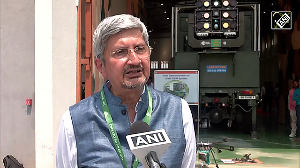| F |
Bangalore, India's software hub, is now seeing companies place Bonsai trees near the cubicles of code writers to soothe their frayed nerves.
Bonsai is fast gaining popularity among IT professionals because of "its aesthetic appeal, therapeutic effect and longevity," says Bonsai Srinivas, the renowned Bonsai expert who has 500 Bonsai tree species to his credit.
Bonsai trees can be kept indoors for two to three days at a stretch. These artistic plants give "out as much oxygen as a fully grown tree, purifying the air while satisfying your creative urges," he says. "Owning a Bonsai has become a matter of prestige among IT professionals as each creation is a work of art."
Bonsai has immense potential and a demand needs to be created through "constant innovation and creation of Bonsai with more species," says G K Vasanth Kumar, director, state horticulture department.
For a Bangalorean who loves greenery notwithstanding the constraints of space in his choc-a-block apartment, Bonsai is the answer, say Vallish Herur and Bhargava of Trees, the only Bonsai outlet of its kind in the city.
"It was our passion for Bonsai that led to the start of this venture," say the duo, who grew up pottering around with Dr H S Nagaraja, Herur's father and a Bonsai expert.
Vallish and Bhargava, who also specialise in Bonsai landscapes, plan to make presentations in IT companies in view of the enthusiasm evinced by IT professionals for Bonsai.
"We have already made one at Phillips; its CEO Bob Hoekstra has bought an eight-year-old juniper landscape from us," Bhargava says.
Sitting amidst their Bonsai creations of pine, fragrant temple trees and juniper, their aim is to create awareness about Bonsai and train people in the art, they says.
"The fact that you take a plant, visualise it in its big tree form, and help it grow into a miniature tree, seeing the change every day even as it retains its genetic characteristics is what makes Bonsai so innovative and unique," Herur says.
Since the necessary moisture content is essential, Bonsai plants need to be watered every day and need sunshine after every three days, Bhargava says.
The plant is initially kept in a big pot till it attains maturity. "Then we visualise what shape the tree would take and wire the branches using soft copper wires. One needs to keep changing the wiring till you get the required shape, which requires a lot of skill," he says.
The plant is then transferred to a shallow container where it grows for about six months before being shifted to a shallow porcelain container. A Bonsai needs to be repotted every one-and-a-half years, Herur says.
Monocot plants with a single shoot like coconut, arecanut or palm cannot be made into Bonsai. In India, Bonsai trees mainly belong to the Ficus species like peepal or banyan, Herur says.
The exotic Bonsai species in India include flowering trees like Muria Exotica, the temple tree, pomegranate, citrus varieties, bottlebursh, Legostomia and rudraksha, Bhargava say.
"We have created a Bonsai of the Indian Lavender, an uncommon tree which flowers only once a year and has leaves for only three months7," he said.
The older the plant, the higher the cost as it needs lot of nurture and care.
The duo have a collection of over 3,000 Bonsai trees in their nursery on the outskirts of the city.
The response to the outlet, which is just one-and-a-half months old, is "very encouraging" with over 200 plants already being sold.
Bangalore has already carved a niche for itself in Bonsai by having the first Bonsai park in the country. The recent addition is the one at Lodhi Gardens in New Delhi.
Address
Trees
c/o Vallish Herur and Bhargava
27, Bull Temple Road
Opposite Ganjam Mantapa
Basavangudi
Bangalore -- 560 004
Phone: (080) 5150 5356







 © 2025
© 2025